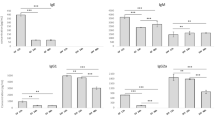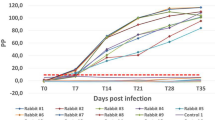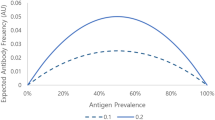Abstract
WHEN newborn animals are immunized with a bacterial antigen, large quantities of the antigen must be injected to elicit a primary antibody response1,2. Similarly, if a primary antibody response is induced in newborn rabbits or in sterile piglets by sheep erythrocytes, the amount of antibody in the serum and the number of antibody-forming cells in the spleen are greater the more antigen is used3,4. In the true primary response, administration of a 75 per cent lethal dose (100 ml. of concentrated suspension of sheep erythrocytes given intraperitoneally to sterile piglets, that is, 2 × 1012 cells) did not immediately inhibit antibody formation. On the contrary, if the number of cells producing haemolytic 19S and 7S antibodies5 is estimated after the intravenous administration to sterile piglets of very large quantities of the antigen (20 ml. of a concentrated suspension of sheep erythrocytes, that is, 4 × 1011 cells), the number of antibody-forming cells in the spleen, where antigen is predominantly localized, is greater than when a similar dose is given sub-cutaneously or intraperitoneally (Fig. 1). The figure shows that the inductive phase—when no antibody-forming cells are detected—lasts 36 h. After this period, there is a rapid increase in the number of antibody-forming cells, at first with a doubling time of 2.6 h, later of 3.3 h. This cannot be considered to result from cell division only. As suggested earlier4, it is supposed that the first antibody-forming cells are thought to be formed by differentiation of preformed competent cells and that the rapid increase in the number of antibody-forming cells results from direct asynchronous differentiation of the pre-existing competent cells. The very small number of immunocompetent cells in lymphoid tissue (approximately one cell/106 lymphoid cells) explains the need to use large quantities of the antigen to evoke a true primary reaction in newborn animals. To make possible chance contact between the few immunocompetent cells and a critical quantity of antigen, substantially more antigen is required than in the hypothetical case when numerous competent cells are present (Fig. 2). The number of cells reacting with the antigen during the secondary reaction was found to be greater by at least two orders of magnitude than the number of cells involved in the primary reaction6. For simplicity, it is assumed that antigen has the same role in the primary and the secondary reactions. On this assumption, to activate the same number of cells in the secondary as in the primary reaction, the amount of antigen which would suffice would be inversely proportional to the number of reacting cells in lymphoid tissue.
This is a preview of subscription content, access via your institution
Access options
Subscribe to this journal
Receive 51 print issues and online access
$199.00 per year
only $3.90 per issue
Buy this article
- Purchase on Springer Link
- Instant access to full article PDF
Prices may be subject to local taxes which are calculated during checkout
Similar content being viewed by others
References
Šterzl, J., and Trnka, Z., Nature, 179, 918 (1957).
Bellanti, J. A., Eitzman, D. V., Robbins, J. B., and Smith, R. T., J. Exp. Med., 117, 479 (1963).
Říha, I., Folia Microbiol., 6, 355 (1961).
Šterzl, J., Veselý, J., Jílek, M., and Mandel, L., in Molecular and Cellular Basis of Antibody Formation (edit. by Šterzl, J.), 463 (Publishing House of the Czechoslovak Acad. Sci., Prague, 1965).
Šterzl, J., and Říha, I., Nature, 208, 858 (1965).
Makinodan, T., and Albright, J. F., in Immunopathology (edit. by Grabar, P., and Miescher, P. A.), 99 (Schwabe and Co., Basel, 1963).
Trávníček, J., Mandel, L., Lanc, A., and Ru̇žička, R., Czech. Physiol., 15, 240 (1966).
Author information
Authors and Affiliations
Rights and permissions
About this article
Cite this article
ŠTERZL, J., JÍLEK, M. Number of Antibody-forming Cells in Primary and Secondary Reactions after Administration of Antigen. Nature 216, 1233–1235 (1967). https://doi.org/10.1038/2161233a0
Received:
Revised:
Published:
Issue Date:
DOI: https://doi.org/10.1038/2161233a0
This article is cited by
-
Gnotobiotic mouse model’s contribution to understanding host–pathogen interactions
Cellular and Molecular Life Sciences (2016)
-
On contacts of immunocompetent cells with antigen (Note on a probability model)
Folia Microbiologica (1971)
-
The antibody response in newborn precolostral germfree piglets following the peroral monocontamination with attenuated teschen disease virus (TDV)
Folia Microbiologica (1971)
-
The elimination of bacteriophages ΦX 174 and T2 from the circulating blood of newborn precolostral pigs
Folia Microbiologica (1970)
-
The probability of contact between the immunocompetent cell and antigen
Folia Microbiologica (1970)
Comments
By submitting a comment you agree to abide by our Terms and Community Guidelines. If you find something abusive or that does not comply with our terms or guidelines please flag it as inappropriate.



